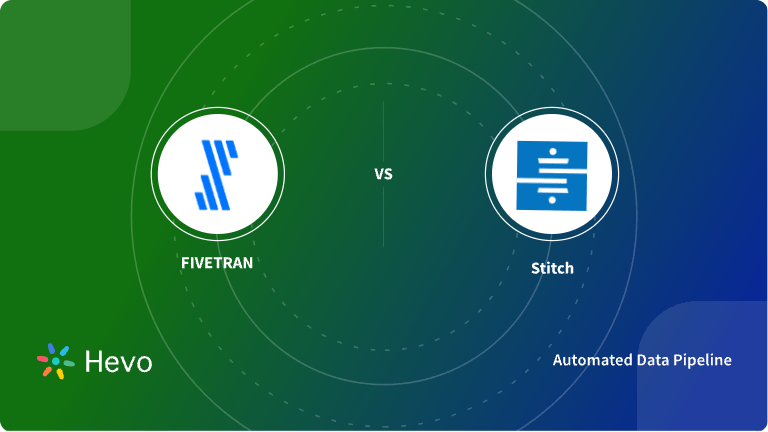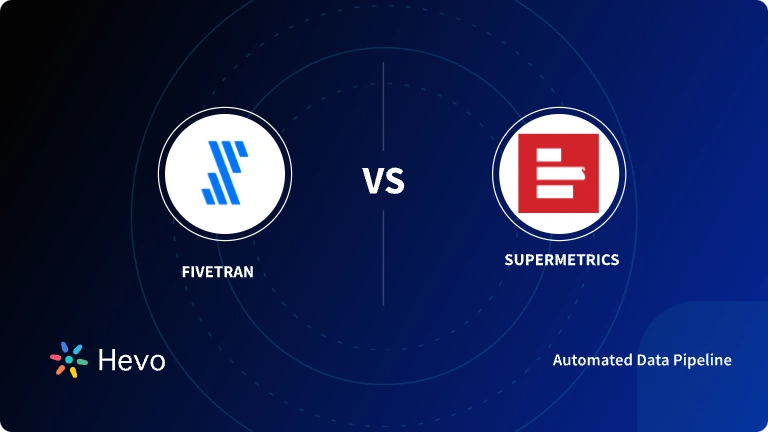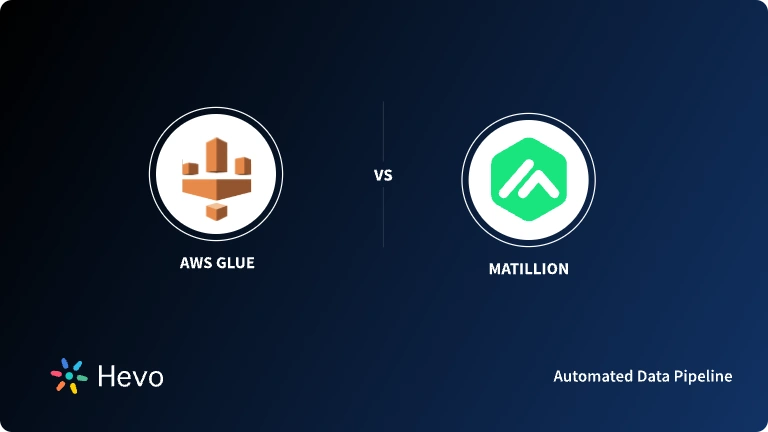 Key Takeaways
Key TakeawaysFivetran and AWS Glue are both powerful ETL tools, but they serve different purposes. While Fivetran offers an easy-to-use, fully managed solution with pre-built connectors, AWS Glue, is a more flexible, serverless data integration service that provides deeper customization options for complex transformations.
Features of Fivetran:
- Fully managed with minimal setup
- Pre-built connectors for a wide range of data sources
- Automated schema migration and data syncing
- Focus on ease of use with minimal maintenance
Features of AWS Glue:
- Serverless architecture for scalable data integration
- Customizable ETL jobs using Python or Spark
- Flexible data transformation and cleansing options
- Seamless integration with AWS services like S3, Redshift, and Athena
When to Choose:
- Fivetran: Choose if you need an easy-to-use, no-code solution with automated data syncing.
- AWS Glue: Choose if you require customizable ETL workflows with deep AWS integration.
- Hevo: Choose if you need real-time data integration with minimal setup and a scalable, no-code platform.
Choosing Fivetran vs. AWS Glue for data integration is challenging, as they offer the same broad ETL services.
Fivetran comes with its user-friendly, automated ELT pipelines and over 700 pre-built connectors. On the other hand, AWS Glue is a serverless ETL solution offering deep AWS integration and customizable transformations.
So, what will you choose? And more importantly, how will you choose, as it will impact your team and your organization?
Trust us, you are not alone in this predicament.
That’s why, in this blog post, we address this dilemma by comparing the unique features, pricing, and use cases of Fivetran vs. AWS Glue in detail.
By the end, you will know with clarity which tool aligns best with your organization’s data strategy and technical requirements.
Let’s get started.
Table of Contents
Overview of Fivetran

G2 Rating: 4.2(377)
Capterra Rating: 4.7(20)
Fivetran is a fully managed data integration platform for businesses with complex, large-scale integration needs.
The platform helps automate data extraction, load, and transformation from 700+ data sources, such as SaaS applications, ERPs, databases, and files, to modern data warehouses, data lakes, and analytical tools. Fivetran automates schema drift, system updates, and pipeline failures while offering zero-maintenance data integration.
It also helps your data flow reliably even as your business scales and systems evolve with its self-healing pipelines and 99.9% system uptime.
Using Fivetran’s data movement platform, your team can:
- Free up time by reducing pipeline fixes and monitoring needs
- Deliver real-time insights at speed across the organization
- Keep your cloud strategy moving without disruption
- Expand AI models confidently and efficiently
Fivetran enables hybrid deployments and provides managed data lake services while ensuring efficient automation, scalability, and enterprise-grade security. As a result, businesses working in highly regulated industries, such as healthcare, finance, retail, etc., find Fivetran ideal to meet their future-proof data infrastructure needs.
Learn More: Discover Top Fivetran Alternatives
Hevo’s no-code platform helps streamline your ETL process. Try Hevo and equip your team to:
- Integrate data from 150+ sources(60+ free sources).
- Utilize drag-and-drop and custom Python script features to transform your data.
- Risk management and security framework for cloud-based systems with SOC2 Compliance.
Try Hevo and discover why 2000+ customers have chosen Hevo over tools like AWS DMS to upgrade to a modern data stack.
Overview of AWS Glue

G2 Rating: 4.2(189)
Capterra Rating: 4.1(10)
Overview of AWS Glue
AWS Glue is a fully managed, serverless ETL (Extract, Transform, Load) service designed for businesses needing scalable, cost-effective data integration within the AWS ecosystem.
The platform automates data discovery, transformation, and loading from diverse sources into data lakes, warehouses, or analytics tools. AWS Glue’s Data Catalog centralizes metadata management and comes with a visual interface and auto-generated code for easy ETL pipeline creation. As one of the top ETL tools, AWA Glue also supports batch, streaming, and ELT workflows with seamless AWS integration.
Using AWS Glue’s serverless data integration, your team can:
- Streamline ETL processes with minimal infrastructure management
- Accelerate analytics with real-time and batch processing
- Scale effortlessly to handle petabyte-scale data
- Enhance data workflows with built-in AI and Spark optimization
- Connect with Amazon S3, RDS, Redshift, and 100+ other data stores
With pay-as-you-go pricing, automatic scaling, and integration with Athena and SageMaker, AWS Glue is ideal for businesses looking for flexible, cloud-native data solutions. Its robust security and automation also make it adept for finance, healthcare, and tech, where reliable, compliant data pipelines are vital.
Learn More: Explore the Top AWS Glue Alternatives
Fivetran vs. AWS Glue vs. Hevo Data: A Quick ETL Tool Comparison
Use Cases
| Criteria | Fivetran | AWS Glue | Hevo Data |
| Automated ETL/ELT | ✅ | ✅ | ✅ |
| Reverse ETL | ✅ (For SaaS apps) | ✅ | ❌ |
| CDC | ✅ | ✅ | ✅ |
| Near real-time | ✅ | ✅ | ✅ |
| Hybrid Deployments | Cloud-focused | AWS-integrated | Limited support |
Connectors
| Criteria | Fivetran | AWS Glue | Hevo Data |
| Source Variety | 700+ connectors | AWS-centric | 150+ connectors |
| Custom Connector Req | ❌ | ✅ | ✅ |
| Real-time Support | ✅ | ✅ | ✅ |
Performance & Scalability
| Criteria | Fivetran | AWS Glue | Hevo Data |
| Auto-scaling | ✅ | ✅ | ✅ |
| High volume | ✅ | High volume | ✅ |
| Petabyte-scale | ✅ | Petabyte-scale | ✅ |
| Real-time data sync | ✅ | Near real-time | ✅ |
| Batch | ✅ | ✅ | ✅ |
| Pre-Load Transformation | ❌ | ✅ | ✅ |
| In-pipeline ELT | ❌ | ❌ | ✅ |
| Ease of Scaling | ✅ | ✅ | ✅ |
Core Features & Abilities
| Criteria | Fivetran | AWS Glue | Hevo Data |
| Data Transformation | dbt integration | Spark, Python/Scala | Python, drag-and-drop |
| Automation | Fully automated | Semi-automated | ✅ |
| No-code pipelines | ✅ | ❌ | ✅ |
| Pipeline Monitoring | Proactive notifications | Limited visibility | Built-in alerts |
| Custom Schema Mapping | ❌ (Automapping only) | ✅ | ✅ |
Security
| Criteria | Fivetran | AWS Glue | Hevo Data |
| Compliance Standards | HIPAA, PCI-DSS | AWS-compliant | SOC2, GDPR |
| Access Control | ✅ | ✅ | ✅ |
| AES encryption | ✅ | ✅ | ✅ |
Cost
| Criteria | Fivetran | AWS Glue | Hevo Data |
| Pricing Model | MAR-based | Pay-as-you-go | Event-based |
| Transparent Pricing | ❌ | Variable | ✅ |
| Vendor Lock-in | No | Yes | No |
Implementation Complexity
| Criteria | Fivetran | AWS Glue | Hevo Data |
| Setup Speed | Quick / Minimal | Complex | Quick / No-code |
| Required Skillset | No-code friendly | Requires coding skills | No-code / Low-code |
Vendor Support
| Criteria | Fivetran | AWS Glue | Hevo Data |
| Support Availability | 24/7 email | Tiered support | 24/7 chat |
| Response Time | Fast | Moderate (Varies by tier) | Fast |
| Documentation | Comprehensive | Comprehensive, but complex | ✅ |
Fivetran vs. AWS Glue: In-depth Feature and Use Case Comparison
Connectors
Fivetran offers over 700 connectors, which is one of the biggest advantages of using the platform. These connectors enable users to seamlessly integrate with databases, cloud storage, and SaaS platforms like Salesforce and Google Analytics.
Fivetran’s extensive, pre-built connectors simplify data ingestion, which makes it one of the top data pipeline tools for businesses with diverse data sources, including legacy systems.
Users on G2 praised Fivetran’s vast connector library for its ease and reliability.

At the same time, AWS Glue supports over 70 data sources, primarily AWS-centric, like S3, RDS, and Redshift. It excels in AWS-native environments but lacks the breadth of SaaS connectors. This is one area where AWS Glue features come short for businesses outside the AWS ecosystem.
As such, businesses that have systems outside the AWS ecosystem will have a tough time integrating AWS Glue into them.
Verdict: Fivetran’s superior connector range makes it the clear winner here.
Vendor Support
Fivetran provides robust vendor support with 24/7 email and chat availability based on the plan you are on. Its support team is known for proactive communication and offers detailed guidance for setup and troubleshooting.
However, not all plans have full support. For example, only higher-level plans have a Service Level Agreement (SLA) with one-hour response support.
This is reflected in many Fivetran reviews on G2:

Similarly, AWS Glue also offers tiered vendor support. Its basic plans offer limited access, while premium tiers provide 24/7 phone, email, and chat support.
Its documentation is extensive but often complex, which may require its users to be familiar with AWS ecosystems.
However, despite the shortcomings, many users have rated the platform’s support positively on G2:

Verdict: There is no clear winner in this criterion, as both Fivetran and AWS Glue have limitations when it comes to vendor support.
Learn More: A Comprehensive Guide to Learn All About AWS Glue ETL
Deployment Options
Fivetran offers a fully managed, cloud-based deployment model that helps streamline data integration with minimal setup.
It supports hybrid deployments and allows on-premises data sources to connect securely to cloud destinations. This makes Fivetran ideal for businesses seeking simplicity and flexibility across diverse environments without managing infrastructure.
AWS Glue is a serverless ETL service deployed within the AWS ecosystem. This enables the platform to seamlessly integrate AWS services like S3, Redshift, and Aurora.
Although it supports cloud-native and hybrid setups, it requires configuration for on-premises data. Glue’s serverless model suits AWS-centric organizations comfortable with managing AWS infrastructure dependencies.
Verdict: Fivetran’s simple, fully managed deployment options make it better for businesses that need flexibility. However, for businesses already in the AWS ecosystem, AWS Glue is the better choice.
Learn More: AWS Glue Tutorial: Learn All About AWS Glue
Data handling and transformation
Fivetran excels in automated ELT with seamless data extraction and loading from 700+ sources with built-in normalization.
Its transformation capabilities rely on dbt integration for SQL-based custom transformations. For anyone who wants simplicity, this is a great choice. However, complex transformations may require external tools.
Fivetran’s focus on simple data transformation needs has enabled it to receive a positive response from its users on G2:

At the same time, AWS Glue provides robust data handling with Apache Spark for large-scale ETL. This makes it ideal for businesses that need Python and Scala for custom transformations.
For AWS-centric teams needing powerful, code-driven transformations, there is no better option than this, thanks to the robust AWS Glue architecture.
Verdict: There is no clear winner here, as AWS Glue wins for complex transformations, while Fivetran is better for automated, simpler workflows.
Pricing
Fivetran pricing is consumption-based, calculated by Monthly Active Rows (MAR) processed. It starts with a free tier for 500,000 MAR.
Although the cost scale with data volume in Fivetran, its pricing lacks transparency, with enterprise plans being costly for high usage. This is a concern that might alienate potential buyers from Fivetran.
Many users of the platform have noted expensive bills due to variable data processing, as pointed out by the following user on G2.

AWS Glue uses a pay-as-you-go model. While it is cost-effective for AWS-native users, the overall cost can be unpredictable and complex.
AWS Glue cost may not be an ideal situation that many businesses would appreciate as they have no control over the pricing with high data processing needs.
You can see a similar sentiment reflected in the following user’s review of AWS Glue on G2:

Verdict: While Fivetran suits predictable, smaller workloads, AWS Glue is more cost-effective for AWS ecosystems. Although both come with their limitations, in terms of cost-effectiveness, AWS Glue edges out Fivetran to be the winner.
Why is Hevo Data better than Fivetran and AWS Glue?
Of course, Fivetran and AWS Glue offer extensive ETL capabilities. However, they also come with a range of limitations in terms of custom schema mapping, pricing issues, pre-load transformation, ELT streaming support, and ease of use.
But when it comes to Hevo Data, it outperforms these tools in most of these categories.
Check out the following reasons why Hevo Data is better than Fivetran and AWS Glue.
Real-time data replication and streaming
Hevo Data utilizes log-based Change Data Capture (CDC) and Kafka-based streaming to deliver real-time data replication. This ensures near-instantaneous data updates for businesses to analyze data as it arrives.
For time-sensitive applications like fraud detection or live analytics, this is ideal. This is because Hevo’s low-latency ingestion minimizes delays to ensure high-frequency data flow from diverse data sources.
Businesses can make faster and data-driven decisions and ensure agility thanks to Hevo’s real-time data replication and streaming.
No-code setup and user-friendly interface
Hevo Data’s no-code platform simplifies data pipeline creation with a four-step setup process.
Its drag-and-drop interface and pre-built templates streamline configuration, enabling pipelines in minutes. This ease of use reduces reliance on data engineers, saving time and resources.
Flexible and robust data transformations
Hevo Data supports ETL and ELT with diverse transformation options, such as in-flight, drag-and-drop, and Python-based transformations.
You can streamline your data preparation processes with Hevo Data without relying on external tools. This flexibility allows you to carry out diverse use cases, such as simple data cleaning, complex workflows, and more with Hevo Data. With Hevo’s intuitive transformation capabilities, teams can prepare data for analytics or diverse AI models efficiently.
As a result, you can improve efficiency and productivity across your technical and nontechnical users.
Cost-effectiveness and transparent pricing
Hevo Data’s event-based pricing starts with a free plan offering 1 million events monthly, which makes it ideal for testing.
All the paid plans, such as Starter ($239/month, 5M events), Professional ($679/month, 20M events), and Business Critical (custom pricing), provide clear, predictable costs. Hevo has also tailored these plans to meet the unique needs of businesses, from small and medium businesses to mid-market and enterprise businesses.
The cost is also transparent with predictable billing, eliminating the chances of billing surprises. This transparency helps businesses budget effectively, especially for variable data volumes.
Hevo’s affordable pricing model ensures scalability without hidden fees, making it a cost-effective choice for growing organizations.
Learn More: Hevo vs. Fivetran: Who Can Drive Your Data Strategy Forward Better
Customer support and assistance
Hevo Data offers 24/7 email and in-app chat support across paid plans. It also offers comprehensive documentation and Hevo Smart Assist for proactive guidance.
Users on the Business Critical plan can also seek a 1-hour SLA to solve urgent issues that, if unresolved, may impact their operations.
With reliable and accessible support, Hevo Data focuses on minimizing downtime and enhancing user experience, regardless of team size or technical expertise.
Take the first step to reducing your total cost of ownership by 50% and save 30% of your analytics team’s time. Sign up for a 14-day free trial with Hevo.
FAQ on Fivetran vs AWS Glue
Does Hevo have better performance compared to Fivetran or AWS Glue in terms of data syncing in real-time?
Yes, Hevo offers real-time syncing, while Fivetran supports near real time. AWS Glue, on the other hand, is focused on batch ETL.
Which one has better customer support?
Hevo offers live chat support even with the low price tier; however, Fivetran and AWS Glue have limited support options unless you are in their higher-tier plans.
Is migration from AWS Glue to Hevo without vendor locking possible?
Yes, the flexible architecture of Hevo prevents vendor locking; thus, the ability to switch to other tools or adapt to new technologies would be easier in the long run.





